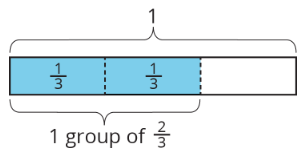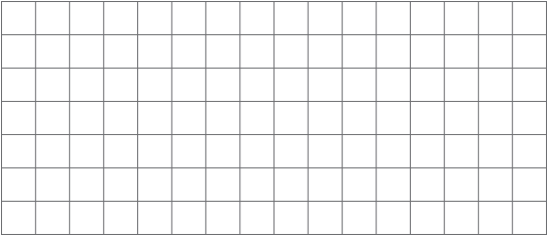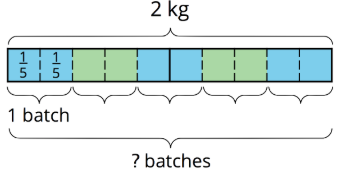22.3: Using Diagrams to Find the Number of Groups
( \newcommand{\kernel}{\mathrm{null}\,}\)
Lesson
Let's draw tape diagrams to think about division with fractions.
Exercise
- We can think of the division expression

- Complete the tape diagram to represent the question: “How many groups of 2 are in 7?” Then find the answer.

Exercise
To make sense of the question “How many

- In an earlier task, we used pattern blocks to help us solve the equation
- Write a multiplication equation and a division equation for each question. Then, draw a tape diagram and find the answer.
- How many

- How many

- How many

Exercise
- Write a multiplication equation or a division equation for each question. Then, find the answer and explain or show your reasoning.
- How many
- How many groups of
- How many
- Write a question that can be represented by the division equation
Summary
A baker used 2 kilograms of flour to make several batches of a pastry recipe. The recipe called for
We can think of the question as: “How many groups of
To help us make sense of the question, we can draw a tape diagram. This diagram shows 2 whole kilograms, with each kilogram partitioned into fifths.

We can see there are 5 groups of
Notice the number of groups that result from
Suppose one serving of rice is

Looking at the diagram, we can see there are 4 full groups of
Practice
Exercise
We can think of
Exercise
Describe how to draw a tape diagram to represent and answer
Exercise
How many groups of
- Write a multiplication equation or a division equation to represent the question.
- Draw a tape diagram to show the relationship between the quantities and to answer the question. Use graph paper, if needed.
Exercise
Diego said that the answer to the question “How many groups of
Exercise
Select all the equations that can represent the question: “How many groups of
(From Unit 4.2.2)
Exercise
Calculate each percentage mentally.
- What is
- What is
- What is
- What is
- What is
- What is
- What is
- What is
(From Unit 3.4.5)

